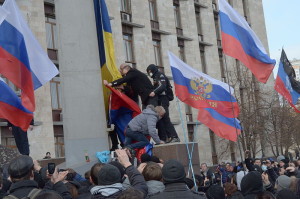Why Russia’s Resurgence Won’t Lead to War
Twenty-four years after the end of the Cold War, few people anticipated a resurgent Russia to once again become a threat to NATO member states. Russia’s most recent military foray, its growing expeditionary force in Syria, seems to illustrate just how little America and its allies can do to stop it. However, despite declarations of an impending showdown between NATO and its old nemesis, Russia and the West will not be fighting a war in the near future. Since the conflict in Ukraine began, analysis of Russia’s intentions has focused on the Russian military’s vastly improved capabilities, strategic initiative, and cunning. In one fell swoop, Russian troops were able to seize control of the Crimean Peninsula with little bloodshed, all while complicating the world’s response by discretely supporting separatist movements in eastern Ukraine. Per the Putin Doctrine, many leaders and analysts within the international community fear that the same fate is in store for other states with significant Russian ethnic minorities. The Ukraine conflict, now compounded by Russia’s incursion into Syria, attests to the nonconformist nature of Putin’s foreign agenda.
This analysis, however, has largely ignored the massive economic cost these decisions have imposed on Russia. In Crimea, the almost bloodless seizure has resulted in an economic bloodletting; the Kremlin itself announced that it would cost $4.5 billion annually in capital investments alone to modernize Crimea. On top of that are the costs of planned high-profile construction projects which, despite being designed to show the world the benefits of Russian rule, may actually bankrupt the government instead. Furthermore, the income that Crimea once brought in through trade and tourism has now dropped to practically nothing. Inflation has skyrocketed to 42.5% and the local government is overwhelmed by corruption. To deal with Crimea’s governance issues, the Kremlin announced that it would be providing $18 billion in federal aid over the next five years. Russia’s annexation of Crimea may take decades to pay off, if it ever does, and has resulted in sanctions that have hamstrung the greater Russian economy.
These consequences are reflected in current GDP projections. This year, the International Monetary Fund projects that the Russian economy will shrink 3%, with EU and American sanctions potentially cutting Russia’s GDP by an additional 9%. In addition to the sanctions, the volatility of the global oil market has left the Russian export market reeling. With 68% of its export proceeds coming from oil, Russia’s economy has suffered from OPEC’s race to the bottom, and will continue to do so, due to the coming influx of Iranian oil. Every dollar drop in the price of oil leaves Russian companies $2 billion poorer, and yet Russia continues to double down on the oil market by investing in its state run fossil fuel energy companies.
Clearly, Russia is in no position to finance conflicts beyond the ones in which it is currently entangled.While Putin correctly predicted NATO’s unwillingness to go to war over Crimea and Donbass, he underestimated the EU’s tough sanctions and overestimated the strength of his emaciated economy. The economic consequences of just one relatively minor engagement in Ukraine has left Putin’s Russia crippled and in no state to weather a high-intensity conflict.
Still, Putin has proven to be bold and unpredictable. Finding support in Russian nationalism, his approval rating has only risen as the economy continues to flounder; pursuing further glory in the name of the Russian people theoretically would not be out of the question. However, the common thread throughout the conflicts that Putin has pursued in recent years is that none of the states were members of NATO. This establishes a problematic precedent, as all other states with ethnically Russian groups are, for the most part, under the protective gaze of NATO.
While its willingness to utilize its overwhelming military force has been questioned, NATO commanders have repeatedly stated that any attack, regardless of its origin, would be met with a joint military response. General Philip Breedlove, NATO’s Supreme Allied Commander, has specified that even anonymous, seemingly-stateless foreign troops, like those supporting separatist forces in the eastern Ukraine, would be cause enough to enact Article Five, NATO’s collective call to arms clause. In order to complement the continued militarization of European states, American troop levels in the Baltics and Eastern Europe have been increased and would act as a tripwire force for larger American involvement in any conflict. While a recent Foreign Policy article revealed that American military planners are worried about their ability to win a war in the Baltics against Russia with current troop levels, the point is moot. After all, in order to seize a Baltic state, Russia would have to commit to a large assault on joint NATO-U.S. forces, which would surely provoke an escalation in violence that it would not be able to sustain.
Putin and his compatriots have dug themselves in too deep in Ukraine and Syria. The Ukraine conflict has left the Russian economy in shambles, and Assad’s withering grip on power has left Putin betting on the wrong horse. The growing expeditionary force in Syria should not be seen as a sign of growing Russian strength, but as a confirmation of Russia’s wavering military and economic power. While it would be folly to say that Putin’s next step will be predictable, the evidence clearly shows that the Russian leadership has effectively limited the extent of its foreign policy going forward.

